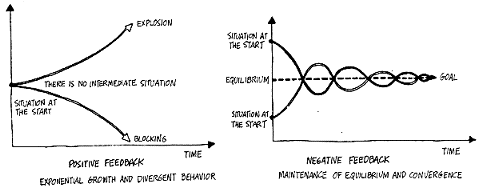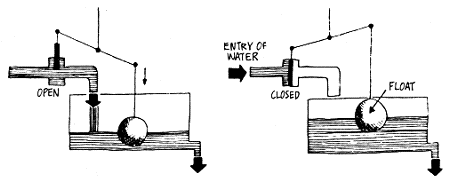In a system where a transformation occurs, there are inputs and outputs.
The inputs are the result of the environment's influence on the system,
and the outputs are the influence of the system on the environment.
Input and output are separated by a duration of time, as in before and
after, or past and present.

In every feedback loop, as the name suggests, information about the
result of a transformation or an action is sent back to the input of the
system in the form of input data. If these new data facilitate and accelerate
the transformation in the same direction as the preceding results, they
are positive feedback - their effects are cumulative. If the new data produce a result in the opposite direction to previous results, they are negative
feedback - their effects stabilize the system. In the first case there is
exponential growth or decline; in the second there is maintenance of
the equilibrium.

Positive feedback leads to divergent behavior: indefinite expansion or
explosion (a running away toward infinity) or total blocking of activities
(a running away toward zero). Each plus involves another plus; there
is a snowball effect. The examples are numerous: chain reaction, population explosion, industrial expansion, capital invested at compound interest, inflation, proliferation of cancer cells. However, when minus leads
to another minus, events come to a standstill. Typical examples are bankruptcy and economic depression.

In either case a positive feedback loop left to itself can lead only to
the destruction of the system, through explosion or through the blocking
of all its functions. The wild behavior of positive loops - a veritable death
wish - must be controlled by negative loops. This control is essential
for a system to maintain itself in the course of time.
Negative feedback leads to adaptive, or goal-seeking behavior: sustaining the same level, temperature, concentration, speed, direction. In some
cases the goal is self-determined and is preserved in the face of evolution:
the system has produced its own purpose (to maintain, for example,
the composition of the air or the oceans in the ecosystem or the concentration of glucose in the blood). In other cases man has determined the
goals of the machines (automats and servomechanisms).
In a negative loop every variation toward a plus triggers a correction
toward the minus, and vice versa. There is tight control; the system
oscillates around an ideal equilibrium that it never attains. A thermostat
or a water tank equipped with a float are simple examples of regulation
by negative feedback.


